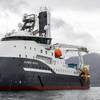Cruise Ships Dump 90% of Grey Water in BC
1.54 billion liters of grey water were generated by ships off the British Columbia coast in 2017 - the equivalent of more than 600 Olympic-size swimming pools, said a study.
World Wildlife Fund Canada says cruise ships traveling between Washington state and Alaska are responsible for dumping "the vast majority" of the potentially toxic grey water that ends up off the B.C. coast each year.
Cruise ships accounted for 1.37 billion (almost 90%) of the 1.54 billion liters of grey water generated off the B.C. coast in 2017, the study revealed.
Grey water — the drainage from dishwater, galley sinks, and showers — may contain contaminants ranging from grease, oil and flame retardants to disinfectants, fecal coliform and micro-plastics, among other substances. Because of limited storage on vessels, it's common practice for ships of all sizes to discharge greywater into the ocean.
“There are several environmental impacts of grey water dumping, including the potential for nutrients in the liquid to foster excessive algal growth, leading to dead zones for aquatic life,” says Andrew Dumbrille, WWF-Canada’s senior specialist, sustainable shipping.
“Grey water can also contain oil and grease that suffocates fish by coating their gills, and particulate matter that chokes species like lobster, crab and sponges,” he adds.
Discharged grey water can potentially impact local ecosystems, especially along coastal areas that are more sensitive to wastewater discharges than the open ocean. Although grey water dumping in inland waters is governed by provincial laws, regulations only cover the area within three nautical miles of the coast. Beyond that, there are no requirements for grey water to be treated or reported when discharged into the oceans.
“We urge Transport Canada to put additional regulations in place around grey water dumping. Some companies voluntarily go beyond what is required, but much more is needed across the industry. With 90 per cent of all grey water likely produced on cruise ships, transparency can help customers make a difference by supporting companies that keep ocean health in mind,” says Dumbrille.
Following on WWF-Canada’s 2018 report which found that grey water dumping in the Canadian Arctic would double by 2035, this report uses a similar methodology to highlight common B.C. coastal routes where grey water was likely released.
Prepared by Vard Marine Inc., this latest report looked at the types of vessels transiting Canadian waters from Washington to Alaska and took into account the routes, average number of passengers, and average amount of grey water generated.












